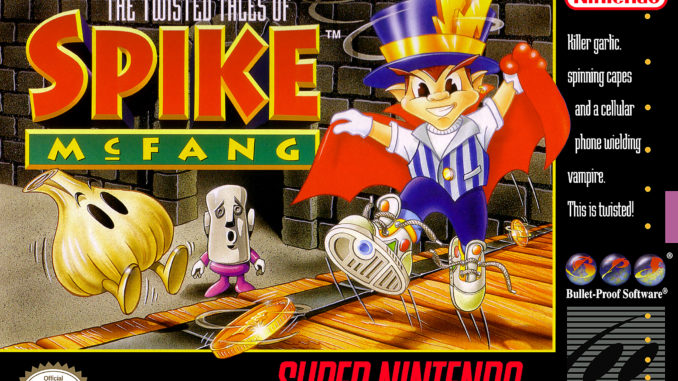
Super Nintendo exclusive upon the time of its initial release, The Twisted Tale of Spike McFang is an action RPG in the truest sense. Launching stateside in June of 1994, spike represented everything Nintendo’s flagship console could achieve at the time. Vibrant sprite animations, computer-controlled companions, parallax scrolling, and an elaborate musical score all merged to create a charming experience that rivaled its contemporaries and paid homage to its predecessors.
Developed by Bulletproof Software, and published by the now-defunct Naxat Soft, Spike Mcfang utilized the elaborate color pallet of the Super Nintendo’s hardware to perfect. The musical score, composed by Hisashi Masashita, held influences of high fantasy medieval adventure twinged with an Elizabethan vibe. Spike McFang had all the presets to become an ongoing franchise.
 But nearly 25 years later, it appears that this was not to be the case. Since the height of the console war between Sega and Nintendo, Spike McFang has seen little fanfare or coverage in the intervening years.
It’s Brilliance
Bulletproof Software created a masterwork in this visually affluent yet charmingly simplistic action RPG. Spike McFang has a lot going for it in terms of gameplay and visual aesthetic. The plot takes your titular hero Spike on a quest to stop the zombie hordes, led by their nefarious general Von Hesler, from conquering the peaceful Kingdom of Carmelia.Â
Though rudimentary in scope, the exposition of the plot is the not the bright spot of this title, but rather, the way in which the narrative unfolds. The core gameplay mechanic revolves around a party member AI accompaniment which allows your protagonist to venture with a secondary fighter.
Similar to the Secret of Mana franchise, this character can also be controlled by a second player, meaning that the game allows for full-on couch co-op, a feature rarely used in Action RPG’s at the time. These secondary fighters come in the form of Camelia, the daughter of the game’s royal family, and Rudy, the son of the wicked Von Hosler.
Each secondary character is as important as the protagonist, providing skillful assist attacks and item sharing that made the adventure seem communal rather than a solitary experience. Spike McFang broke the barrier between single player JRPG’s and more Westernized multiplayer RPG’s by melding AI computer assists with full two-player action.
Bulletproof Software made a wise decision in allowing for their new Action RPG to be played in a multitude of ways, which gave the world of the game a sense of vibrancy and depth of scale. What is even more amazing about the said title is the variation of settings the exposition of the plot touches upon.
From the high walls of Batland Castle to the blistering sands of theKalala Desert, the landscapes provide the player with a sense of grandiosity in scale. Each world design is given such strict attention to detail that it feels as if you are looking at a grand fantasy film rather than a 16-bit mid-90s action RPG. Rarely are the environments monotonous or mundane. The game design is top notch given the restrictive limitations of the hardware it is working with.
Even the choice of animation sprites exudes a reluctance to conformity inherent in the genre. Instead of hearts, the developers implemented tomato juice as the main life source for Spike Mcfang. Rather than swords and shields, Bulletproof Software designed a combat system around the protagonist’s hat and cape.
For his main attack, Spike throws his top hat like a boomerang, that over the course of the story, can be upgraded to greater strength.
The secondary weapon is Spike’s cape, which unlike the distance achieved with his top hat, resembles a hand to hand melee attack.
The protagonist can also use magical cards that as he gains experience points, can be imbued with elemental enchantments that cause greater damage on enemies and even regenerate health for secondary characters. Such notches to the RPG genre without pure imitation of its tropes is what gives this title a unique gameplay aesthetic. But beyond all this nuance, Spike McFang did have its shortcomings that affected its overall reception during the time of its release.
What Happened To Spike McFang
Bulletproof Software may sound impervious to fault with a name like that, but unfortunately, its namesake is misleading. There are fundamental localization flaws and design choices that hampered the overall outcome of Spike McFang during its initial run. The U.S. version was a lot more difficult than its Japanese counterpart, with a greater emphasis on level grinding and coin collecting that rendered the American localization inaccessible to its audience.
This ramped up the difficulty in the U.S. version is most evidenced in the final act of the game. Once Spike enters the land surrounding Carmelia Castle, he starts earning 50 piece gold coins with each enemy slain. But up to that point, players are lucky to receive 10 piece gold coins.
The hampering of expensive coinage forces players to grind heavily right from the beginning of the story which had the adverse effect of turning off most of the non-RPG consumer base in America at the time. It was not until the release of Final Fantasy 7, some four years later, that the U.S. market truly started to appreciate the grinding aesthetics of RPG’s in the years to come.
Even enemies were much harder in the North American iteration of Spike McFang. Players had to excessively grind for hours in order to progress the plot of the story and at times even had to reface the same enemies in order to gain experience points. Unlike the game it sought to imitate, The Legend of Zelda, Spike McFang seems to be at a crossroads when it comes to its gameplay mechanics.
By incorporating such needless stat based character progression, the developers created a product that was difficult just for the sake of being so. These experience points did little else to change the trajectory of Spike’s inventory nor did it enhance his AI companion.
Grinding can be a worthwhile experience when it achieves a fundamental purpose in an RPG. But Bulletproof Software missed the point of gaining experience points and this intense complexity in such a visually animated title is bewildering. Spike McFang presented a depth of complexity to an audience that was not ready for the RPG revolution that had spread in the Asian markets for years up until that point.
Most of the American console market saw high fantasy gaming as a PC solely experience, rarely venturing outside of the sports and platforming genres that had consumed North America during those early years. Spike McFang, on the surface, is a typical isometric adventure. But looks can be deceiving, and certainly, in this instance, it is. Thus, Spike McFang, with all its brilliance, still managed to undermine itself by burying its gameplay in overly complex mechanics.
In Hindsight
With all its wonderful and charming visuals, greater landscapes, and depth of scale, Spike McFang is definitely worth checking out if you can find it at a fair price. Retro enthusiasts would be wise to venture into the world of this action RPG and hack their way to Von Hosler’s keep. This title remains an oddity in the Super Nintendo’s library. It imbues itself in a milieu of JRPG tropes that was unheard of in the  Westernized action-adventure genre.
As prices continue to rise on SNES cartridges, it seems like this title will be doomed to collector obscurity. The Nintendo virtual console is not likely to give rise on the Switch any time soon, Spike McFang may see new life on reproduction cartridges in the near future. If this title is anything else, it is a lesson in not compromising majestic simplicity for mindless complexity.
Perhaps Americans were not ready for a difficult role-playing experience in the mid-90s. A remastered version on the Switch would be a great addition to Nintendo’s new flagship console, and in hindsight, quite possible when one views the current state of the retro gaming market.


Leave a Reply